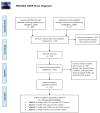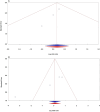Association of TNF-α genetic variants with neonatal bronchopulmonary dysplasia: consolidated results
- PMID: 39748810
- PMCID: PMC11693615
- DOI: 10.3389/fped.2024.1511355
Association of TNF-α genetic variants with neonatal bronchopulmonary dysplasia: consolidated results
Abstract
Objectives: Inflammation is increasingly recognized as a key factor in the pathophysiology of bronchopulmonary dysplasia (BPD). While previous research has established significant links between TNF-α polymorphisms and BPD susceptibility, further validation of these associations is needed. This study aims to examine the relationship between TNF-α polymorphisms and the risk of BPD.
Methods: All relevant articles published before October 1, 2024, have been screened in the PubMed, Web of Science, CNKI, and Scopus databases.
Results: A total of 14 case-control studies were conducted: five studies with 1,252 cases and 1,377 controls on -308G/A, three studies with 1,180 cases and 1,194 controls on -238G/A, four studies with 149 cases and 192 controls on -857C/T, and two studies with 82 cases and 162 controls on 1,031 T/C. A significant association was found between the TNF-α -238G/A polymorphism and the risk of BPD. However, no significant relationships were observed for the TNF-α -308G/A, -857C/T, and 1,031 T/C polymorphisms regarding BPD susceptibility.
Conclusions: Our findings indicate a significant association between the TNF-α -238G/A polymorphism and the susceptibility to BPD in preterm neonates, suggesting potential biomarkers for its pathogenesis. However, this meta-analysis has limitations, including possible publication bias and heterogeneity due to the limited number of studies, which may affect the reliability of our conclusions. Moreover, population variability further complicates the interpretation of the link between TNF-α polymorphisms and BPD risk.
Keywords: TNF-α; bronchopulmonary dysplasia; neonate; premature lung diseases; preterm.
© 2024 Shams, Dastgheib, Mousavi-Beni, Hosein Lookzadeh, Mirjalili, Golshan-Tafti, Bahrami, Yeganegi, Shahbazi, Masoudi, Shiri, Noorishadkam and Neamatzadeh.
Conflict of interest statement
The authors declare that the research was conducted in the absence of any commercial or financial relationships that could be construed as a potential conflict of interest.
Figures





Similar articles
-
A Comprehensive Consolidation of Data on the Relationship Between Surfactant Protein-B (SFTPB) Polymorphisms and Susceptibility to Bronchopulmonary Dysplasia.Fetal Pediatr Pathol. 2024 Nov-Dec;43(6):436-454. doi: 10.1080/15513815.2024.2400145. Epub 2024 Sep 8. Fetal Pediatr Pathol. 2024. PMID: 39245635
-
Association of tumor necrosis factor-α gene polymorphisms and coronary artery disease susceptibility: a systematic review and meta-analysis.BMC Med Genet. 2020 Feb 11;21(1):29. doi: 10.1186/s12881-020-0952-2. BMC Med Genet. 2020. PMID: 32046680 Free PMC article.
-
Association of TNF-α-308G/A, -238G/A, -863C/A, -1031T/C, -857C/T polymorphisms with periodontitis susceptibility: Evidence from a meta-analysis of 52 studies.Medicine (Baltimore). 2020 Sep 4;99(36):e21851. doi: 10.1097/MD.0000000000021851. Medicine (Baltimore). 2020. PMID: 32899013 Free PMC article.
-
Association of TNF-α gene alterations (c.-238G>A, c.-308G>A, c.-857C>T, c.-863C>A) with primary glaucoma in north Indian cohort.Gene. 2019 Aug 15;709:25-35. doi: 10.1016/j.gene.2019.05.035. Epub 2019 May 25. Gene. 2019. PMID: 31132515
-
The association between VEGF genetic variations and the risk of bronchopulmonary dysplasia in premature infants: a meta-analysis and systematic review.Front Pediatr. 2024 Nov 14;12:1476180. doi: 10.3389/fped.2024.1476180. eCollection 2024. Front Pediatr. 2024. PMID: 39611001 Free PMC article.
Cited by
-
Large-Scale Meta-Analysis of TNF-α rs1800629 Polymorphism in Schizophrenia: Evidence from 7,624 Cases and 8,933 Controls.Medeni Med J. 2025 Jun 26;40(2):80-92. doi: 10.4274/MMJ.galenos.2025.72273. Medeni Med J. 2025. PMID: 40569792 Free PMC article.
-
Advancements in biomarkers and machine learning for predicting of bronchopulmonary dysplasia and neonatal respiratory distress syndrome in preterm infants.Front Pediatr. 2025 Apr 25;13:1521668. doi: 10.3389/fped.2025.1521668. eCollection 2025. Front Pediatr. 2025. PMID: 40352605 Free PMC article. Review.
-
Decoding bronchopulmonary dysplasia in premature infants through an epigenetic lens.Front Med (Lausanne). 2025 Apr 3;12:1531169. doi: 10.3389/fmed.2025.1531169. eCollection 2025. Front Med (Lausanne). 2025. PMID: 40248086 Free PMC article. Review.
References
-
- Verder H, Li ZK, Ramanathan R, Clark H, Sweet DG, Schousboe P, et al. Bronchopulmonary dysplasia with focus on early prediction and treatment: a narrative review. Pediatr Med. (2023) 6. 10.21037/pm-21-98 - DOI
-
- Bahrami R, Golshan-Tafti M, Dastgheib SA, Alijanpour K, Yeganegi M, Lookzadeh MH, et al. A comprehensive consolidation of data on the relationship between surfactant protein-B (SFTPB) polymorphisms and susceptibility to bronchopulmonary dysplasia. Fetal Pediatr Pathol. (2024) 43(6):436–54. 10.1080/15513815.2024.2400145 - DOI - PubMed
Publication types
LinkOut - more resources
Full Text Sources

